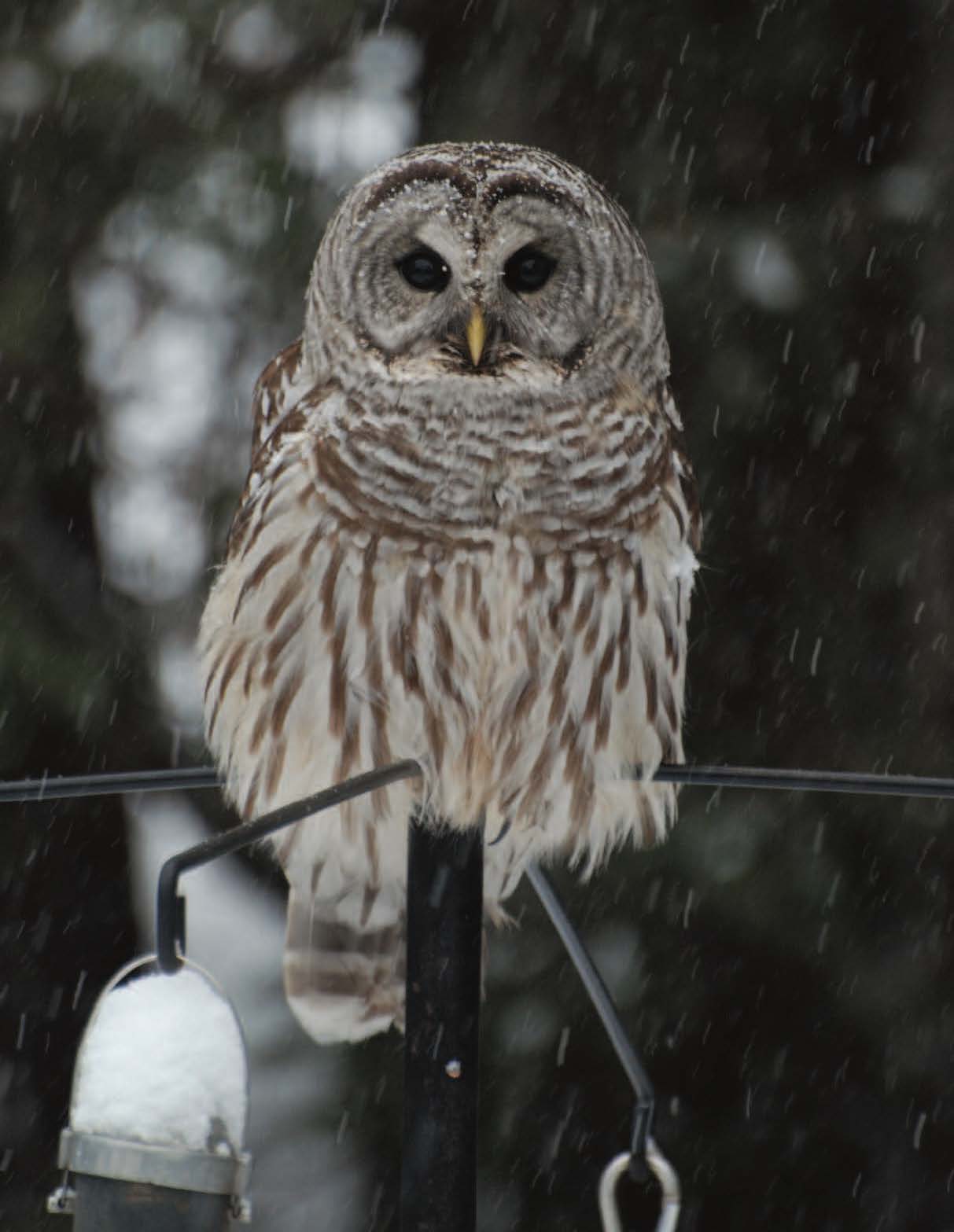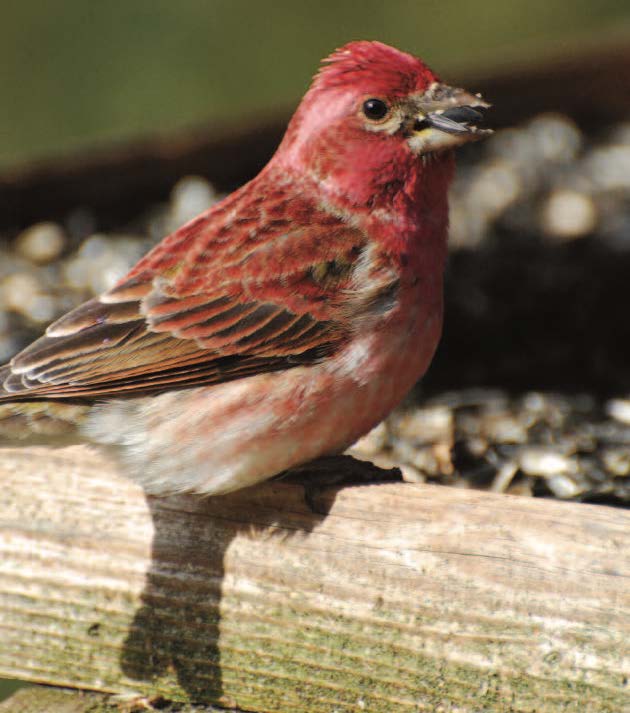
By Heather Clemenson
Cool-weather entertainment just outside your back door
A cedar woodland curves along the west side of our garden to meet part of our deck. The deck wraps around from the west-facing kitchen window to the north side of the house. Between the cedars and the deck, a small area of lawn is home to a central feeding station for the birds. This feeding area is maintained year-round. However, with the onset of the very cold, snowy weather in winter 2018-2019, we began placing additional food along the deck railing. This daily routine provided a wonderful source of entertainment for us, as well as additional nourishment for birds and squirrels.
At the sound of the sliding door opening onto the deck, the birds and squirrels knew that they’d soon have extra food. It was amazing how speedily the word spread that the railing had been re-stocked. If it had snowed overnight, we spent time clearing a pathway around the perimeter of the deck and brushing the snow off the railing, while chirping chickadees and chittering red squirrels provided background noise. Peanuts, slightly chopped in an old coffee grinder, black-oil sunflower seeds and now and then, a generous sprinkling of Niger seeds, were the treats placed along the railing. Immediately after the food was set out, a constant stream of chickadees flew in and out of the cedars to retrieve a chunk of peanut or a single seed, always retreating to the shelter of the trees to eat. Early in the winter, the white-breasted nuthatches would select a nut or seed and consume it while hanging upside down along the edge of the railing. Eventually, they must have decided that feeding upright was acceptable, too, and the upside-down routine seemed to be abandoned.
Blue jays appeared from nowhere and quickly vacuumed up large quantities of seeds and nuts. They did not stay on the railing to eat, but would fly away to cache their collection in some hidey-hole. They would shuttle back and forth for a while and then completely disappear. The female cardinal often visited. Being a regular visitor to the main feeders, she too, came to appreciate the deck railing, resorting to the main feeders only if the railing was cleared of food. She always came first, but sooner or later, the male cardinal would arrive. Other small flocks of birds frequented the railing too. Purple finches made the occasional visit and redpolls, up to 20 at a time appeared in early March. They seemed to multiply overnight and flocks of 40 or more sometimes descended onto the railing. Much smaller groups of goldfinches were steady visitors, still in their drab winter plumage, though hints of brighter yellow began appearing towards the end of March. Slate-colored juncos generally chose to explore the deck surface looking for food that had been pushed off the railing.
Two or three red squirrels would position themselves at intervals along the railing. A battle for railing supremacy sometimes occurred, but they more-or-less came to terms with sharing. Rarely did they allow a gray squirrel to join them on the deck. Usually, our regular group of squirrels, red and gray, share whatever spoils appear on the ground under the main feeders. Towards the end of March one or two chipmunks were also seen on the deck — a sure sign that spring was arriving!
Nine mourning doves regularly flew onto the railing and strutted up and down on their pink legs as though carefully examining food options available. They seemed content to mop-up whatever food remained and stayed long after any nourishment had gone, parking themselves in a sheltered or sunny spot to quietly digest their food. However, the doves never became used to the sliding door opening. While other birds would hop into the cedars and quietly wait until the deck was replenished, the doves would immediately scatter with a flurry of beating wings in an almost vertical ascent to the tops of the cedars. Skittish to say the least!

PHOTO: GARY THOMAS HALL.
At the beginning of winter there had been ten doves, but one day we found a pile of mourning dove feathers close to the main feeders. While we have a neighborhood fox, whose winter tracks frequently could be seen across our back lawn, no evidence of footprints appeared on the snow. We had no idea what had eaten
the dove until early one morning when we saw a barred owl perched on top of the feeders. The owl stayed with us for several days. It caught a rabbit and spent three nights eating it under a shelter of cedar branches. We could watch from the kitchen window in the twilight, as the owl feasted on its catch. It was sad to lose the rabbit, but it was fascinating to watch the owl. We hoped the owl would return in the spring to enjoy a feast of voles that, early in the winter, had already constructed a prodigious network of tracks criss-crossing our lawns under the shallow snow. Sadly, we have not seen the owl again.
Meanwhile, both hairy and downy woodpeckers kept up their steady daily flight to the peanut feeders at the main feeding station. A solitary ruffed grouse also continued to pick up spillage under the main feeders. In late March, we spotted the ruffed grouse precariously perched on our crabapple tree in the back garden eating small frozen crabapples, where it was joined by our first robin. We often wondered — what on earth robins find to eat in a landscape still deep in snow? The answer is crabapples. One morning in early April, we had the ruffed grouse and a rabbit eating together under the crabapple tree and a robin eating overhead. How we wished the camera was immediately at hand.
While we feed birds year-round, the deck routine slowly wound down as the temperatures became less extreme, the daylight grew longer, and other food choices appeared. Though the birds were challenged by the long, cold winter, they did make it an especially interesting one for us. But we do hope that winter 2019-2020 will neither be as long, nor as cold.
Heather Clemenson and her husband Gary Hall live in Greely on a one-acre property that backs onto woodland. They enjoy watching the birds and wildlife that visit their garden. Heather also volunteers with the Master Gardeners of Ottawa-Carleton.






